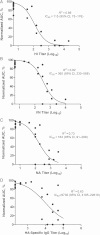Impact of Adjuvants on the Immunogenicity and Efficacy of Split-Virion H7N9 Vaccine in Ferrets
- PMID: 25712975
- PMCID: PMC4598806
- DOI: 10.1093/infdis/jiv099
Impact of Adjuvants on the Immunogenicity and Efficacy of Split-Virion H7N9 Vaccine in Ferrets
Abstract
Background: An effective vaccine is urgently needed against the H7N9 avian influenza virus. We evaluated the immunogenicity and protective efficacy of a split-virion H7N9 vaccine with or without the oil-in-water adjuvants in ferrets.
Methods: Ferrets were vaccinated with 2 doses of unadjuvanted, MF59 or AS03-adjuvanted A/Shanghai/2/2013 (H7N9) vaccine, and the induction of antibodies to hemagglutinin (HA) or neuraminidase proteins was evaluated. Ferrets were then challenged with wild-type H7N9 virus to assess the vaccine's protective efficacy. The vaccine composition and integrity was also evaluated in vitro.
Results: Adjuvanted vaccines stimulated robust serum antibody titers against HA and neuraminidase compared with the unadjuvanted vaccines. Although there was a difference in adjuvanticity between AS03 and MF59 at a lower dose (3.75 µg of HA), both adjuvants induced comparable antibody responses after 2 doses of 15 µg. On challenge, ferrets that received adjuvanted vaccines showed lower viral burden than the control or unadjuvanted vaccine group. In vitro examinations revealed that the vaccine contained visible split-virus particles and retained the native conformation of HA recognizable by polyclonal and monoclonal antibodies.
Conclusions: The adjuvanted H7N9 vaccines demonstrated superior immunogenicity and protective efficacy against H7N9 infection in ferrets and hold potential as a vaccination regimen.
Keywords: H7N9; adjuvants; ferrets; influenza; vaccine.
© The Author 2015. Published by Oxford University Press on behalf of the Infectious Diseases Society of America. All rights reserved. For Permissions, please e-mail: journals.permissions@oup.com.
Figures



References
-
- Human infections with avian influenza A (H7N9) virus 2014. http://www.who.int/influenza/human_animal_interface/RiskAssessment_H7N9_... Accessed 3 March 2014. - PubMed
-
- Gao HN, Lu HZ, Cao B, et al. Clinical findings in 111 cases of influenza A (H7N9) virus infection. N Engl J Med 2013; 368:2277–85. - PubMed
-
- Treanor JJ, Campbell JD, Zangwill KM, Rowe T, Wolff M. Safety and immunogenicity of an inactivated subvirion influenza A (H5N1) vaccine. N Engl J Med 2006; 354:1343–51. - PubMed
Publication types
MeSH terms
Substances
Grants and funding
LinkOut - more resources
Full Text Sources
Other Literature Sources
Medical
Molecular Biology Databases

